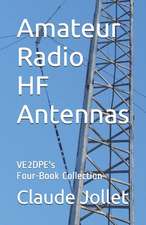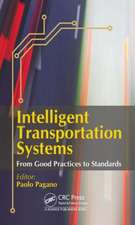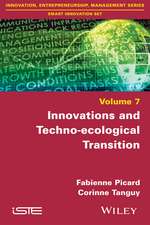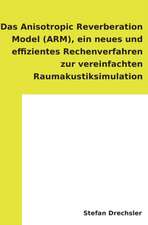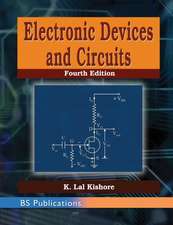Electrical Power System Essentials 2e
Autor P Schavemakeren Limba Engleză Hardback – 6 iul 2017
Preț: 408.63 lei
Preț vechi: 510.78 lei
-20% Nou
Puncte Express: 613
Preț estimativ în valută:
78.20€ • 81.34$ • 64.56£
78.20€ • 81.34$ • 64.56£
Carte disponibilă
Livrare economică 24 martie-07 aprilie
Livrare express 07-13 martie pentru 39.06 lei
Preluare comenzi: 021 569.72.76
Specificații
ISBN-13: 9781118803479
ISBN-10: 1118803477
Pagini: 420
Dimensiuni: 157 x 243 x 28 mm
Greutate: 0.71 kg
Ediția:2nd Edition
Editura: Wiley
Locul publicării:Chichester, United Kingdom
ISBN-10: 1118803477
Pagini: 420
Dimensiuni: 157 x 243 x 28 mm
Greutate: 0.71 kg
Ediția:2nd Edition
Editura: Wiley
Locul publicării:Chichester, United Kingdom
Public țintă
Primary: Second and third year undergraduate electrical engineering students who need an accessible course text introducing concepts in power system engineeringSecondary: Postgraduate students from a range of disciplines who are interested in working in the field of power systems, and need an up–to–date reference on the technology
Cuprins
Preface xi List of Abbreviations xvii List of Symbols xix 1 Introduction to Power System Analysis 1 1.1 Introduction 1 1.2 Scope of the Material 2 1.3 General Characteristics of Power Systems 5 1.3.1 AC versus DC Systems 5 Shape of the alternating voltage 6 Sinusoidal alternating voltage 7 1.3.2 50 and 60 Hz Frequency 9 1.3.3 Balanced Three-Phase Systems 10 Power considerations 12 Rotating magnetic field 14 1.3.4 Voltage Levels 17 Line-to-line and line-to-neutral voltages 19 1.4 Phasors 20 1.4.1 Network Elements in the Phasor Domain 22 1.4.2 Calculations in the Phasor Domain 24 1.5 Equivalent Line-to-neutral Diagrams 28 1.6 Power in Single-phase Circuits 30 1.6.1 Active and Reactive Power 31 1.6.2 Complex Power 34 1.6.3 Power Factor 38 1.7 Power in Three-phase Circuits 40 1.8 Per-unit Normalization 41 1.9 Power System Structure 45 Problems 47 References 49 2 The Generation of Electric Energy 51 2.1 Introduction 51 2.2 Thermal Power Plants 53 2.2.1 The Principles of Thermodynamics 53 2.3 Nuclear Power Plants 58 2.3.1 Nuclear Fission 59 2.3.2 Nuclear Fusion 62 2.4 Renewable Energy 63 2.4.1 Wind Energy and Wind Turbine Concepts 63 2.4.2 Hydropower and Pumped Storage 67 2.4.3 Solar Power 69 2.4.4 Geothermal Power 71 2.5 The Synchronous Machine 74 Problems 82 References 84 3 The Transmission of Electric Energy 85 3.1 Introduction 85 3.2 Transmission and Distribution Network 86 3.3 Network Structures 89 3.4 Substations 91 3.5 Substation Concepts 93 3.5.1 Single Bus System 94 3.5.2 Double Bus System 95 3.5.3 Polygon Bus System 96 3.5.4 One-and-a-Half Circuit Breaker Concept 96 3.6 Protection of Transmission and Distribution Networks 97 3.6.1 Protective Relay Operating Principles 99 3.6.2 Fuses 104 3.6.3 Circuit Breakers 106 3.6.4 The Switching Arc 107 3.6.5 Oil Circuit Breakers 109 3.6.6 Air-Blast Circuit Breakers 109 3.6.7 SF6 Circuit Breakers 110 3.6.8 Vacuum Circuit Breakers 112 3.7 Surge Arresters 113 3.8 Transformers 115 3.8.1 Phase Shifts in Three-Phase Transformers 119 3.8.2 The Magnetizing Current 123 3.8.3 Transformer Inrush Current 126 3.8.4 Open Circuit and Short Circuit Tests 127 3.9 Power Carriers 129 3.9.1 Overhead Transmission Lines 131 Insulators 131 Bundled conductors 134 Galloping lines 138 Ground wires or shield wires 141 Transposition 144 3.9.2 Underground Cables 145 Plastic insulation 147 Paper-oil insulation 148 3.9.3 Gas-Insulated Transmission Lines 151 3.10 High-Voltage Direct Current Transmission 152 From AC to DC 156 Problems 160 References 161 4 The Utilization of Electric Energy 163 4.1 Introduction 163 4.2 Types of Load 164 4.2.1 Mechanical Energy 165 Synchronous motors 166 Induction motors 168 4.2.2 Light 171 4.2.3 Heat 173 4.2.4 DC Electrical Energy 173 4.2.5 Chemical Energy 175 4.3 Classification of Grid Users 177 4.3.1 Residential Loads 177 4.3.2 Commercial and Industrial Loads 179 4.3.3 Electric Railways 180 Problems 182 Reference 184 5 Power System Control 185 5.1 Introduction 185 5.2 Basics of Power System Control 187 5.3 Active Power and Frequency Control 190 5.3.1 Primary Control 190 5.3.2 Secondary Control or Load Frequency Control (LFC) 196 5.4 Voltage Control and Reactive Power 198 5.4.1 Generator Control (AVR) 199 5.4.2 Tap-Changing Transformers 201 5.4.3 Reactive Power Injection 203 Static shunt capacitors and reactors 203 Synchronous compensators 204 Static var compensator (SVC) 204 Static synchronous compensator (STATCOM) 206 5.5 Control of Transported Power 207 5.5.1 Controlling Active Power Flows 207 The phase shifter 208 5.5.2 Controlling Reactive Power Flows 210 Static series capacitors 211 Thyristor-controlled series capacitor (TCSC) 211 Static synchronous series compensator (SSSC) 212 5.5.3 Unified Power Flow Controller (UPFC) 214 5.6 Flexible AC Transmission Systems (FACTS) 215 Problems 215 References 218 6 Energy Management Systems 219 6.1 Introduction 219 6.2 Load Flow or Power Flow Computation 220 6.2.1 Load Flow Equations 220 6.2.2 General Scheme of the Newton-Raphson Load Flow 230 6.2.3 Decoupled Load Flow 234 6.2.4 DC Load Flow 238 Active power equations 239 Reactive power equations 240 6.3 Optimal Power Flow 241 6.4 State Estimator 242 6.4.1 General Scheme of the State Estimator 245 6.4.2 Bad Data Analysis 247 6.4.3 Statistical Analysis of the State Estimator 254 Properties of the estimates 254 Bad data detection 255 Bad data identification 256 Problems 257 References 260 7 Electricity Markets 261 7.1 Introduction 261 7.2 Electricity Market Structure 262 7.2.1 Transmission and Distribution 262 7.2.2 Market Architecture 263 7.3 Market Clearing 265 7.4 Social Welfare 267 7.5 Market Coupling 269 7.6 Allocation Mechanism and Zonal/Nodal Markets 274 References 277 8 Future Power Systems 279 8.1 Introduction 279 8.2 Renewable Energy 280 8.3 Decentralized or Distributed Generation 281 8.4 Power-Electronic Interfaces 285 8.5 Energy Storage 286 8.6 Blackouts and Chaotic Phenomena 287 8.6.1 Nonlinear Phenomena and Chaos 287 8.6.2 Blackouts 290 References 298 A Maxwell's Laws 299 A.1 Introduction 299 A.2 Power Series Approach to Time-Varying Fields 300 A.3 Quasi-static Field of a Parallel-plate Capacitor 302 A.3.1 Quasi-static Solution 303 A.3.2 Validity of the Quasi-static Approach 305 A.4 Quasi-static Field of a Single-turn Inductor 307 A.4.1 Quasi-static Solution 308 A.4.2 Validity of the Quasi-static Approach 310 A.5 Quasi-static Field of a Resistor 312 A.5.1 Quasi-static Solution 312 A.6 Circuit Modeling 315 Reference 316 B Power Transformer Model 317 B.1 Introduction 317 B.2 The Ideal Transformer 317 B.3 Magnetically Coupled Coils 320 B.3.1 Equivalence with the Ideal Transformer 323 B.4 The Nonideal Transformer 324 B.5 Three-Phase Transformer 327 C Synchronous Machine Model 329 C.1 Introduction 329 C.2 The Primitive Synchronous Machine 329 C.3 The Single-Phase Synchronous Machine 335 C.4 The Three-Phase Synchronous Machine 341 C.5 Synchronous Generator in the Power System 345 D Induction Machine Model 349 D.1 Introduction 349 D.2 The Basic Principle of the Induction Machine 350 D.2.1 A Single Rotor Winding 351 D.2.2 Two Rotor Windings 354 D.2.3 Rotating Rotor 354 D.3 The Magnetic Field in the Air Gap 356 D.3.1 Contribution of the Rotor Currents to the Air-Gap Field 356 D.3.2 The Flux Linkage with the Stator Windings 359 D.4 A Simple Circuit Model for the Induction Machine 360 D.4.1 The Stator Voltage Equation 360 D.4.2 The Induction Machine as Two Magnetically Coupled Coils 361 D.4.3 A Practical Model of the Induction Machine 362 D.5 Induction Motor in the Power System 363 E The Representation of Lines and Cables 365 E.1 Introduction 365 E.2 The Long Transmission Line 365 E.3 The Medium-Length Transmission Line 370 E.4 The Short Transmission Line 371 E.5 Comparison of the Three Line Models 371 E.6 The Underground Cable 374 Solutions 375 Further Reading 391 Index 393

